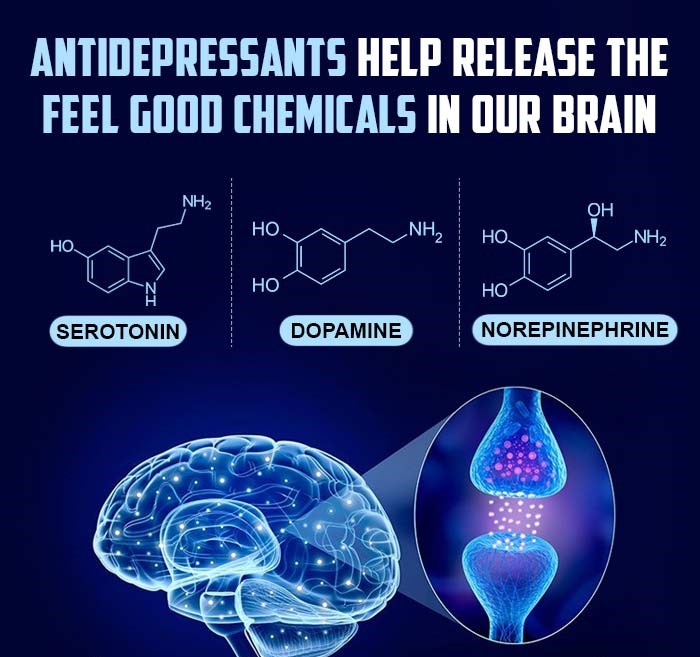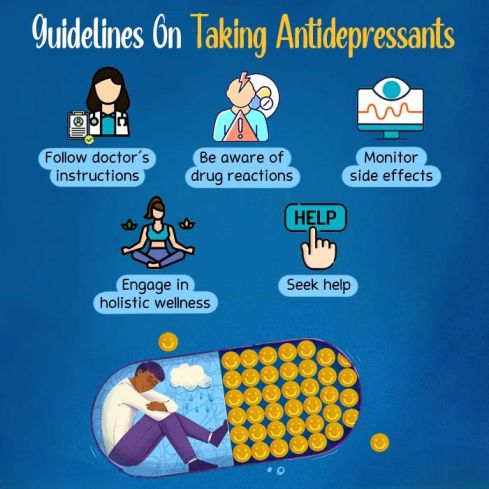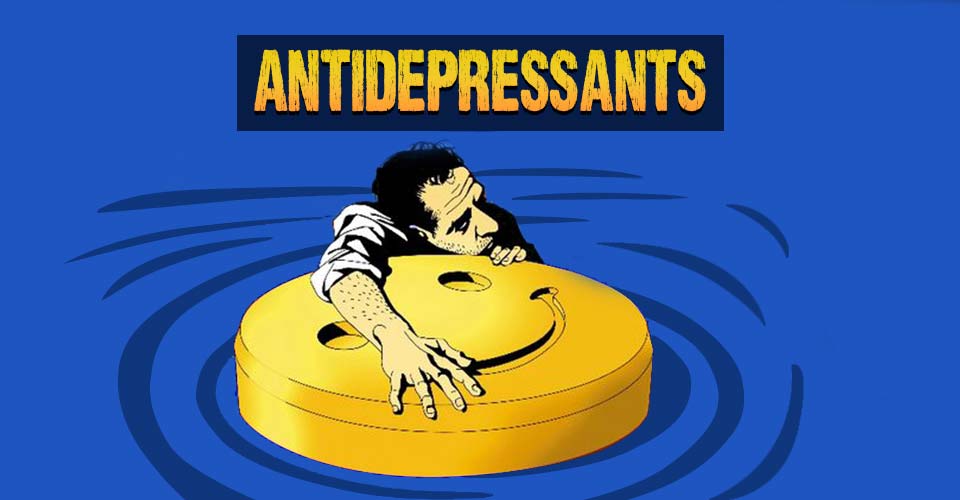Antidepressants are a type of medication primarily used to relieve the symptoms of depression. They act on neurotransmitters involved in mood regulation.
What Are Antidepressants?
Antidepressants are a class of drugs that are used to reduce or relieve symptoms of disorders such as depression. They work by correcting imbalances in our neurotransmitters which are considered to be responsible for alterations in our mood and behavior 1 National Library of Medicine. 2020. Depression: How effective are antidepressants?. Available at: https://www.ncbi.nlm.nih.gov/books/NBK361016/ [Accessed 29 August 2022]. . They were first introduced for use to the general public in 1950.
It must however be noted that antidepressants are by no means a cure for depression and are not a long-term solution. Depression is caused by a combination of psychological, biological, and social factors like family history, lifestyle, and coping skills, which pharmacotherapy alone may not be able to address.
Read More About Major Depressive Disorder Here
How Do Antidepressants Work?
Most antidepressants focus on monoamine neurotransmitter function 2 Harmer, C. J., Duman, R. S., & Cowen, P. J. (2017). How do antidepressants work? New perspectives for refining future treatment approaches. The lancet. Psychiatry, 4(5), 409–418. https://doi.org/10.1016/S2215-0366(17)30015-9 . Our brain contains three primary monoamines that are responsible for our mood regulation. These are:

- Serotonin is responsible for regulating our overall mood, sleep, memory, appetite, sexual desires and even our social behavior 3 Bamalan, O. A., Moore, M. J., & Al Khalili, Y. (2022). Physiology, Serotonin. In StatPearls. StatPearls Publishing. Available from: https://www.ncbi.nlm.nih.gov/books/NBK545168/ . It helps to stabilize our mood and helps us maintain a general feeling of well-being.
- Dopamine regulates our decision-making capabilities, our motivation, symptoms and signals of rewards and pleasure, and our arousal. It is also known as the “feel good chemical” 4 Sonne J, Goyal A, Lopez-Ojeda W. Dopamine. [Updated 2022 Jul 4]. In: StatPearls [Internet]. Treasure Island (FL): StatPearls Publishing; 2022 Jan-. Available from: https://www.ncbi.nlm.nih.gov/books/NBK535451/ as it is linked to how happy we feel overall. It can also affect our memory, focus, and movement.
- Norepinephrine is linked to our overall alertness and arousal 5 Smith MD, Maani CV. Norepinephrine. [Updated 2022 May 15]. In: StatPearls [Internet]. Treasure Island (FL): StatPearls Publishing; 2022 Jan-. Available from: https://www.ncbi.nlm.nih.gov/books/NBK537259/ . It is responsible for our reaction time and also our ability to focus and concentrate but excess secretion can make us feel anxious or restless, which is marked by an increase in our heartbeat and blood pressure.
When people suffer from depression, the concentration of these chemicals in their brains reduces. Antidepressants are known to work by increasing the availability of these neurotransmitters in different ways.
Most of the common antidepressants come in tablet form. A doctor usually prescribes the lowest possible dosage for you to start with. This helps to ease some of the side effects. Most people begin to feel the effect 6 InformedHealth.org [Internet]. Cologne, Germany: Institute for Quality and Efficiency in Health Care (IQWiG); 2006-. Depression: How effective are antidepressants? [Updated 2020 Jun 18]. Available from: https://www.ncbi.nlm.nih.gov/books/NBK361016/ of antidepressants in a week.
If more than a month passes without any changes in mood, you should talk to your psychiatrist about it. The recommended duration of treatment for antidepressants is around four to nine months. However, in some cases, people have been known to continue medication for many years.
It is important for a patient to have regular appointments with their psychiatrist when the treatment is ongoing so that the progress can be monitored effectively. The doctor may readjust the dosage or ask the patient to switch to a different drug if necessary.
The dosage of the drugs is gradually reduced as the treatment nears its end. A person in this stage may experience insomnia, restlessness, and nausea. Although antidepressants do not cause physical dependence or addiction, coming off them can be hard for some people and they might need post-therapy counseling.
Read More About Insomnia Here
Types Of Antidepressants
Antidepressants are classified according to their mechanism of action. There are 5 classes of antidepressants and each of them works in a slightly different way than the other 7 Sheffler, Z. M., & Abdijadid, S. (2022). Antidepressants. In StatPearls. StatPearls Publishing; Available from: https://www.ncbi.nlm.nih.gov/books/NBK538182/ .

1. SSRIs (Selective Serotonin Reuptake Inhibitors)
Reuptake inhibitors primarily work by preventing our neurotransmitters from getting reabsorbed. They work collectively to ensure that all the neurotransmitters secreted by our brain are active and available to use. Selective Serotonin Reuptake Inhibitors 8 Chu A, Wadhwa R. Selective Serotonin Reuptake Inhibitors. [Updated 2022 May 8]. In: StatPearls [Internet]. Treasure Island (FL): StatPearls Publishing; 2022 Jan-. Available from: https://www.ncbi.nlm.nih.gov/books/NBK554406/ work by preventing the reabsorption of serotonin in our body.
They are useful for treating
- Depression
- ADHD (Attention Deficit Hyperactivity Disorder)
- OCD (Obsessive Compulsive Disorder)
- Eating Disorders
- Premature Ejaculation.
They tend to have lesser side effects than other types of antidepressants. Some examples of SNRIs are Citalopram, Fluvoxamine, Paroxetine, etc.
Read More About Attention Deficit Hyperactivity Disorder (ADHD) Here
2. SNRIs (Serotonin and Norepinephrine Reuptake Inhibitors)
SNRIs work in a manner similar to that of SSRIs. SNRIs 9 Sansone, R. A., & Sansone, L. A. (2014). Serotonin norepinephrine reuptake inhibitors: a pharmacological comparison. Innovations in clinical neuroscience, 11(3-4), 37–42. help to inhibit or prevent the reabsorption of both serotonin and norepinephrine by the body. They are a relatively new class of antidepressants.
Research has shown increasing norepinephrine and serotonin levels to be useful in people who have slowed movements and fuzzy thoughts. SNRIs have been shown to be particularly useful in treating –
- Chronic pain
- Generalized anxiety disorder
- Social anxiety disorder
- Post-traumatic stress disorder
- Nerve pain
Some common side effects of SNRIs are –
- Fatigue
- Drowsiness
- Constipation
- Nausea
3. TCAs (Tricyclic Antidepressants)
Tricyclic antidepressants are named as they have three rings in their atomic structure. They were one of the first antidepressants to be used and till today are considered to be effective 10 Moraczewski J, Aedma KK. Tricyclic Antidepressants. [Updated 2022 May 2]. In: StatPearls [Internet]. Treasure Island (FL): StatPearls Publishing; 2022 Jan-. Available from: https://www.ncbi.nlm.nih.gov/books/NBK557791/ in dealing with depression and other mental health conditions.
These drugs work by allowing more of your norepinephrine and serotonin to be released into your brain. Thus, they have an elevated effect on your mood. These drugs are generally prescribed to those individuals who do not respond well to other types of treatments. They are also used for people suffering from migraine and chronic pain.
However, tricyclical antidepressants affect our motor movement and may interfere with our digestion. They also sometimes block a naturally occurring chemical in our body called histamine 11 Parsons, M. E., & Ganellin, C. R. (2006). Histamine and its receptors. British journal of pharmacology, 147 Suppl 1(Suppl 1), S127–S135. https://doi.org/10.1038/sj.bjp.0706440 . This can lead to –
- Dry mouth
- Blurred vision
- Glaucoma
- Constipation
4. MAOIs (Monoamine Oxidase Inhibitors)
This drug primarily works by inhibiting the action of a brain enzyme called monoamine oxidase. Monoamine oxidase breaks down neurotransmitters like serotonin in our brains. When MAOIs 12 Sub Laban T, Saadabadi A. Monoamine Oxidase Inhibitors (MAOI) [Updated 2022 Jul 19]. In: StatPearls [Internet]. Treasure Island (FL): StatPearls Publishing; 2022 Jan-. Available from: https://www.ncbi.nlm.nih.gov/books/NBK539848/ inhibit the action of this enzyme, more serotonin gets available for use in our brain.
This leads to stabilization of mood and decreased levels of anxiety. MAOIs are used in cases where SSRIs do not work. They affect other medications and food items and thus can produce unwanted side effects.
Some of the commonly reported side effects of MAOIs are –
- Blurred vision
- Edema
- Weight loss or gain
- Seizures
- Anxiety
- Insomnia
- Drowsiness among others
5. NASSA (Noradrenaline and Specific Serotonergic Antidepressants)
This class of drugs works by increasing amounts of serotonin and noradrenaline in our synaptic cleft, which is the space between our neurons where neurotransmitters send and receive messages.
It also helps to block some serotonin receptors in our brain and thus, makes available more serotonin for our brain to use. Some of the side effects of NASSAs 13 Kishi, T., & Iwata, N. (2014). Meta-analysis of noradrenergic and specific serotonergic antidepressant use in schizophrenia. The international journal of neuropsychopharmacology, 17(2), 343–354. https://doi.org/10.1017/S1461145713000667 are –
- Dizziness
- Drowsiness
- Dry mouth
- Constipation
- Weight gain
Atypical Antidepressants
Apart from the typical 5 classes, there exists another class of antidepressants which includes drugs such as bupoprion. A need for atypical antidepressants 14 Horst, W. D., & Preskorn, S. H. (1998). Mechanisms of action and clinical characteristics of three atypical antidepressants: venlafaxine, nefazodone, bupropion. Journal of affective disorders, 51(3), 237–254. https://doi.org/10.1016/s0165-0327(98)00222-5 was recognized as traditional antidepressant that produces a lot of side effects. Moreover, depression came to be seen as a disorder with several underlying features of anxiety, OCD, etc.
Atypical antidepressants have a unique mechanism of action, wherein they target different neurotransmitters at once and produce relatively fewer side effects.
Uses Of Antidepressants
Antidepressants are approved 15 Sheffler ZM, Abdijadid S. Antidepressants. [Updated 2022 Jul 6]. In: StatPearls [Internet]. Treasure Island (FL): StatPearls Publishing; 2022 Jan-. Available from: https://www.ncbi.nlm.nih.gov/books/NBK538182/ by the U.S. Food and Drug Administration (FDA) in treating the following mental disorders:
- Depression [Continue reading]
- Bipolar Disorder [Continue reading]
- Obsessive-Compulsive Disorder (OCD) [Continue reading]
- Social Phobia [Continue reading]
- Panic Disorder [Continue reading]
- Generalized Anxiety Disorder (GAD) [Continue reading]
- Post-Traumatic Stress Disorder (PTSD) [Continue reading]
Contraindications of Antidepressants
While antidepressants may be significantly helpful in reducing symptoms of depression, there are quite a few contraindications 16 Sheffler ZM, Abdijadid S. Antidepressants. [Updated 2022 Jul 6]. In: StatPearls. Treasure Island (FL): StatPearls Publishing; Available from: https://www.ncbi.nlm.nih.gov/books/NBK538182/ to its use as well. For instance:
- People who are suffering from comorbid disorders and taking other psychotropic medications should exercise caution in using antidepressants, as the medicines might interfere with each other.
- Tricyclic antidepressants should not be preferred for people who are suffering from cardiovascular diseases.
- Antidepressants such as bupoprion cannot be used for people with seizure disorders.
It is important to provide an accurate history of your health conditions to your doctor so that adverse effects can be avoided.
Side Effects Of Antidepressants
Most antidepressants today are considered generally safe. However, different people react differently to medications. Thus, the Food and Drug Administration has made it mandatory for all antidepressant drugs to come with a black box warning 17 Delong C, Preuss CV. Black Box Warning. [Updated 2022 Jun 23]. In: StatPearls [Internet]. Treasure Island (FL): StatPearls Publishing; 2022 Jan-. Available from: https://www.ncbi.nlm.nih.gov/books/NBK538521/ , which is the strictest of all warnings for prescription drugs. Some of the general side effects 18 Ferguson J. M. (2001). SSRI Antidepressant Medications: Adverse Effects and Tolerability. Primary care companion to the Journal of clinical psychiatry, 3(1), 22–27. https://doi.org/10.4088/pcc.v03n0105 of antidepressants are:
- Feelings of agitation
- Indigestion and stomach pain
- Constipation and Diarrhoea
- Dizziness
- Loss of appetite
- Insomnia
- Low sex drive
- Erectile dysfunction in men
- Blurring of vision and cottonmouth
- Urinary problems
- Excessive sweating
- Tachycardia
- Weight loss or gain
Apart from these, some other serious adverse effects of these medications may include:
1. Serotonin syndrome
According to research 19 Simon LV, Keenaghan M. Serotonin Syndrome. [Updated 2022 Jul 19]. In: StatPearls [Internet]. Treasure Island (FL): StatPearls Publishing; 2022 Jan-. Available from: https://www.ncbi.nlm.nih.gov/books/NBK482377/ , Serotonin syndrome is a result of serotonergic drug use and can be a potential threat to life. This syndrome occurs when individuals have high levels of serotonin in their brain. It can be caused due to an overdose of certain antidepressants like SSRIs and SNRIs. Some common effects of serotonin syndrome are:
- Diarrhea
- Sweating
- Shivering
- Agitation
- Confusion
- Muscles twitching
Individuals in severe cases can experience seizures, irregular heartbeats and even unconsciousness.
2. Hyponatremia
Hyponatremia 20 Rondon H, Badireddy M. Hyponatremia. [Updated 2022 Jan 31]. In: StatPearls [Internet]. Treasure Island (FL): StatPearls Publishing; 2022 Jan-. Available from: https://www.ncbi.nlm.nih.gov/books/NBK470386/ is an electrolyte abnormality caused by an increase in the ratio of total body water to total body sodium content. This symptom is especially common in elderly people who take antidepressants.
It is caused by the action of SSRIs, resulting in a drastic decrease in the levels of sodium in our bodies. This can cause fluid to build up inside our cells, which can be life-threatening in some situations. Effects of hyponatremia include:
- Headache
- Feeling sick
- Muscle pain
- Confusion
- Reduced appetite
- Feeling exhausted
- Seizures
- Disorientation
In severe cases, individuals may be unable to breathe and may fall into a coma.
3. Suicidal thoughts
Suicide risk 21 Rajgadhi, H., Gupta, S., Malhotra, S. D., Thakor, A., & Patel, P. (2016). Antidepressants triggering suicidal ideation: An area of concern. Indian journal of pharmacology, 48(6), 733–735. https://doi.org/10.4103/0253-7613.194842 is common in individuals under the age of 25, who use antidepressants. This is because these drugs interact with the way natural chemicals in our body get secreted.
Evidence suggests that Selective Serotonin Reuptake Inhibitors (SSRIs) may cause worsening of suicidal ideas 22 Nischal, A., Tripathi, A., Nischal, A., & Trivedi, J. K. (2012). Suicide and antidepressants: what current evidence indicates. Mens sana monographs, 10(1), 33–44. https://doi.org/10.4103/0973-1229.87287 in vulnerable patients. Young people may experience feelings of self-harm within the first few weeks of starting antidepressants.
Natural Antidepressants
Recently, there has been a rise in the popularity of natural alternatives 23 Mischoulon D. (2009). Update and critique of natural remedies as antidepressant treatments. Obstetrics and gynecology clinics of North America, 36(4), 789–x. https://doi.org/10.1016/j.ogc.2009.10.005 24 Iovieno, N., Dalton, E. D., Fava, M., & Mischoulon, D. (2011). Second-tier natural antidepressants: review and critique. Journal of affective disorders, 130(3), 343–357. https://doi.org/10.1016/j.jad.2010.06.010 for antidepressant medication. Some of these are:
- St. John’s Wort
- S-adenosyl methionine (SAMe)
- Omega 3 fatty acids
- Rhodiola rosea
- Chromium
- 5-HTP
- Inositol, etc.
It should be noted that natural antidepressants are not completely devoid of side effects, and you must avoid self-medicating.
Precautions For Antidepressants
It is good to be aware of the type of drug you are taking and its health implications. Doctors should also endeavor to educate people about the safe usage of such drugs to avoid any unwanted side effects.
You may take note of the following before starting antidepressants.

1. Follow instructions properly
When you are taking medications for mental disorders, it is advised that you follow your doctor’s prescription 25 Eisenberg Center at Oregon Health & Science University. Choosing Antidepressants for Adults: Clinician’s Guide. 2007 Aug 15. In: Comparative Effectiveness Review Summary Guides for Clinicians [Internet]. Rockville (MD): Agency for Healthcare Research and Quality (US); 2007-. Available from: https://www.ncbi.nlm.nih.gov/books/NBK43419/ word by word. Never skip a dosage or take more than the prescribed quantity.
Stop your medication only when your doctor advises you to do so. Even if you feel that you might be getting better, stopping medication on your own might result in relapse.
2. Be aware of possible drug interactions
Sometimes, certain drugs and alcohol can react with food items 26 Bushra, R., Aslam, N., & Khan, A. Y. (2011). Food-drug interactions. Oman medical journal, 26(2), 77–83. https://doi.org/10.5001/omj.2011.21 or other medications and supplements you might be taking. For example, SNRIs and SSRIs can interact with some painkillers, blood thinners, and antihistamines, which are commonly found in over-the-counter medicines for allergies, common cold, and sleep.
The reaction can be severe in some cases. Hence, it is advisable to let your doctor know of any other medication or food supplement you are taking.
3. Monitor your side effects closely
It is advised to keep track of any physical and emotional changes in your body. You should always inform your doctor about any side effects and contact them immediately if you find your symptoms deteriorating.
4. Engage in a holistic wellness regimen
If you abuse drugs 27 Evans, E. A., & Sullivan, M. A. (2014). Abuse and misuse of antidepressants. Substance abuse and rehabilitation, 5, 107–120. https://doi.org/10.2147/SAR.S37917 and substances, you may not fare well in your treatment. If you are addicted to substances 28 Torrens, M., Fonseca, F., Mateu, G., & Farré, M. (2005). Efficacy of antidepressants in substance use disorders with and without comorbid depression. A systematic review and meta-analysis. Drug and alcohol dependence, 78(1), 1–22. https://doi.org/10.1016/j.drugalcdep.2004.09.004 , you can always talk to a therapist about coming off it.
You should eat a healthy diet each day and also get plenty of sleep. Exercise can also help uplift your mood and alleviate some of the side effects of these drugs.
5. Seek help
Although antidepressants are not addictive, many people experience withdrawal symptoms, once their treatment gets over. To avoid this, you can seek counseling or psychotherapy in order to help you cope with withdrawl. Psychotherapy can also go hand in hand with medication for better results.
Takeaway
Antidepressants can go a long way in helping people with depression and other related health conditions. However, they should be used with precaution and never without a doctor’s prescription. Little is known about their side effects till now and it is best treated as a category of drugs that has the potential to be harmful to people.
At A Glance
- Antidepressants are a type of medication which is used to relieve the symptoms of depression, among other disorders.
- They are also used to treat other conditions like anxiety disorder, social anxiety disorder, and other types of mental health disorders.
- Most people start to feel the effect of antidepressants within seven days.
- Although antidepressants are not addictive, many people experience withdrawal symptoms, once their treatment gets over.
Frequently Asked Questions (FAQs)
1. How long does it take for antidepressants to work?
It might take about a week for antidepressants to show positive results.
2. What happens when someone overdoses on antidepressants?
Antidepressant overdose can result in a number of effects, ranging from nausea to even death. You should exercise caution while taking antidepressants as taking more than the necessary dose can worsen your condition. 29 Hawton, K., Bergen, H., Simkin, S., Cooper, J., Waters, K., Gunnell, D., & Kapur, N. (2010). Toxicity of antidepressants: rates of suicide relative to prescribing and non-fatal overdose. The British journal of psychiatry : the journal of mental science, 196(5), 354–358. https://doi.org/10.1192/bjp.bp.109.070219
3. Are mood stabilizers safer than antidepressants?
Not necessarily. Both mood stablizers and antidepressants come with their own side effects. Mood stablizers are used to treat symptoms of mania in bipolar disorders whereas antidepressants are used for treating depression.
4. Why do antidepressants cause weight changes?
The exact cause of weight changes as a result of antidepressant use is still being researched. However, it is theorized that weight gain could be due to changes in hormone levels or a sign of improvement 30 Fava M. (2000). Weight gain and antidepressants. The Journal of clinical psychiatry, 61 Suppl 11, 37–41. in people who were losing weight as a result of depression.
5. What are some withdrawal symptoms when someone stops taking antidepressants?
Fatigue, headaches, nausea, sweating, insomnia, sensory disturbances, imbalance and hyperarousal are some of the withdrawal symptoms caused by antidepressants, also known as antidepressant discontinuation syndrome 31 Gabriel, M., & Sharma, V. (2017). Antidepressant discontinuation syndrome. CMAJ : Canadian Medical Association journal = journal de l’Association medicale canadienne, 189(21), E747. https://doi.org/10.1503/cmaj.160991 .















